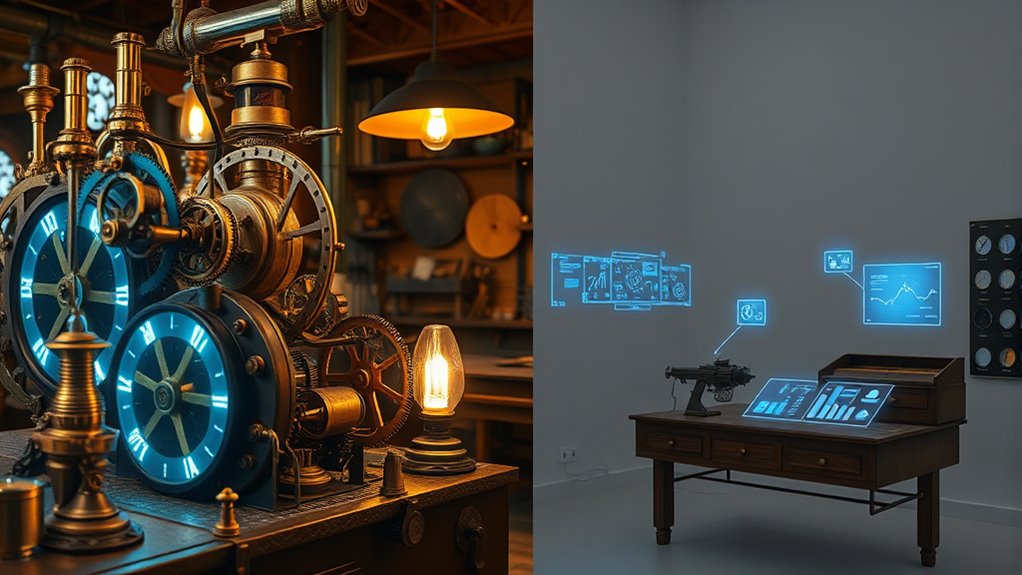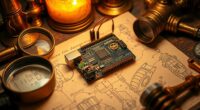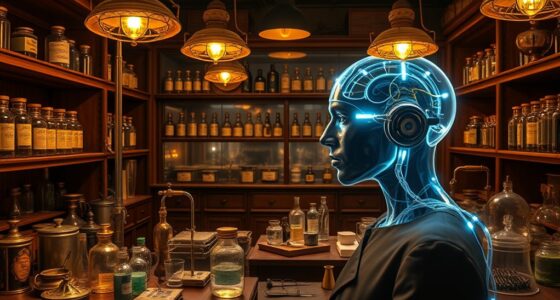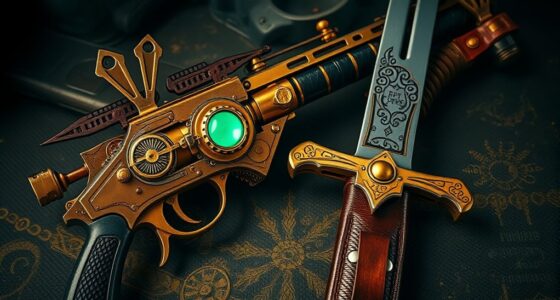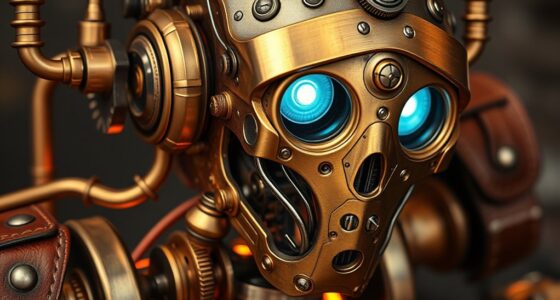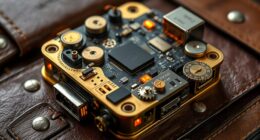Victorian automata, powered by clockwork mechanisms, showcased mechanical precision and artistic craftsmanship that aimed to mimic human actions, reflecting early curiosity about creating intelligent machines. Modern AI, however, relies on complex algorithms, large data sets, and digital architecture to emulate cognition, learning, and decision-making. While Victorian automata focus on physical mastery, today’s AI emphasizes computational power and adaptability. If you continue exploring, you’ll uncover how these innovations connect across eras and shape current technology.
Key Takeaways
- Victorian automata used gears and springs for pre-programmed actions, while modern AI relies on algorithms and data processing.
- Automata mimicked human tasks mechanically, whereas AI aims to replicate human cognition and decision-making digitally.
- Victorian innovations emphasized craftsmanship and mechanical artistry; today’s AI focuses on computational power and learning.
- Automata represented mechanical mastery and aesthetic beauty; AI emphasizes adaptability and data-driven insights.
- Both eras reflect a pursuit to emulate and surpass human abilities, with Victorian automata laying conceptual groundwork for modern AI.
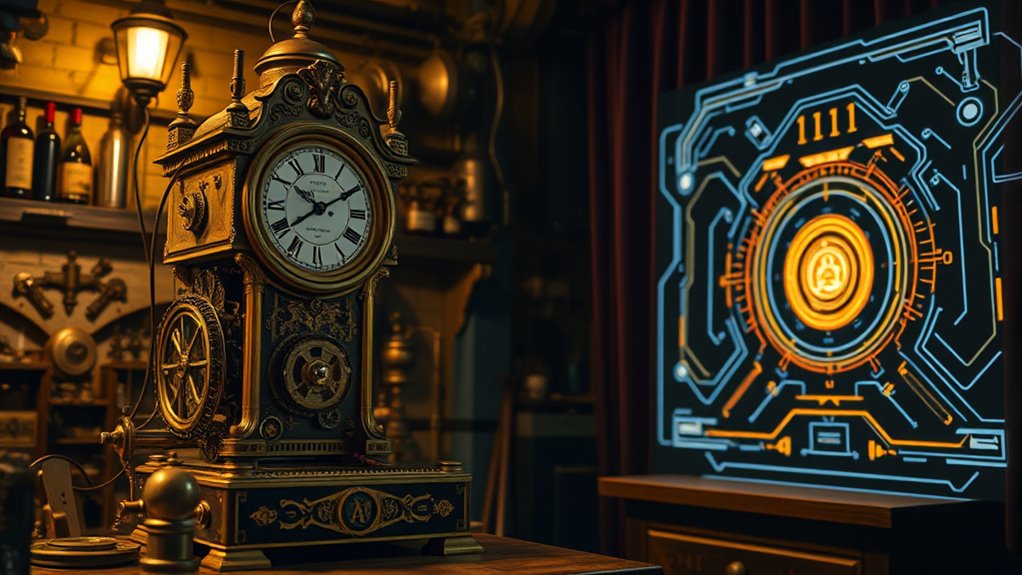
Victorian AI blends the innovation of modern artificial intelligence with the aesthetic and cultural influences of the Victorian era. Imagine a world where steam-powered inventions and Victorian scientific discoveries laid the groundwork for the intricate clockwork automata that fascinated society. During this period, technological progress wasn’t just about functionality; it was about blending engineering with artistry. These early innovations relied heavily on gears, springs, and levers, creating machines that could mimic human actions with remarkable precision. You might have seen these automata perform simple tasks, like writing or playing music, but they were also symbols of Victorian ingenuity and curiosity. They embodied the era’s fascination with mechanical mastery and the desire to create life-like machines, all powered by steam and clockwork mechanisms. Victorian scientists and inventors made significant discoveries that propelled this technological wave. They understood the principles of physics, mechanics, and materials, applying them to craft devices that seemed almost alive. These discoveries paved the way for more complex automata, which were admired for their craftsmanship and ingenuity. Yet, despite their sophistication, these creations lacked true intelligence; they operated solely on pre-programmed movements. The craftsmanship involved in creating these automata reflected a deep understanding of mechanical engineering, which was essential for their precise functioning.
Fast forward to today, and you see AI as a different beast altogether. Modern artificial intelligence, built on complex algorithms and vast data sets, aims to replicate human cognition, learning, and decision-making. Unlike Victorian automata, which could only perform predefined actions, AI can adapt, analyze, and evolve over time. When you compare the two, it’s clear that Victorian AI was rooted in physical, mechanical ingenuity, while today’s AI is founded in digital architecture. Still, you can draw parallels: both eras are driven by a desire to push boundaries and emulate human capabilities. Victorian automata reflect the era’s obsession with mechanical precision and aesthetic beauty, while modern AI emphasizes computational power and data-driven insights. They’re different in execution but similar in intent—to mimic, enhance, and sometimes surpass human abilities. Victorian innovations laid the conceptual groundwork, inspiring future generations to explore automation and intelligence. Today’s AI continues that tradition, blending scientific discoveries with cutting-edge technology to forge new frontiers. The Victorian era’s fascination with steam-powered inventions and scientific breakthroughs set the stage for the modern age’s digital marvels, showing how curiosity and creativity can evolve across centuries.
Frequently Asked Questions
Were Victorian Automata Considered True Artificial Intelligence?
You wonder if Victorian automata were considered true artificial intelligence. Back then, automata’s authenticity was debated—they mimicked life but lacked Victorian consciousness, making many see them as clever illusions rather than genuine intelligence. While they impress with intricate movements, they don’t possess self-awareness or understanding. Today, we recognize that Victorian automata showcased remarkable craftsmanship but didn’t meet the criteria for true AI, which involves consciousness and adaptive thinking.
How Did Victorian Engineers Simulate Human-Like Behavior?
Imagine stepping into a world of intricate magic where Victorian engineers craft mechanical mimicry to imitate human behavior. They use precision craftsmanship innovation, designing tiny gears and levers that bring automata to life. These marvels dance and speak, mimicking actions with delicate accuracy. Though not truly intelligent, their artistry captures the essence of human movement, transforming cold metal into enchanting performers that delight and astonish, blurring the line between machine and living soul.
What Materials Were Used in Victorian Clockwork Automata?
You’ll find that Victorian clockwork automata used materials rooted in materials innovation and craftsmanship techniques. They often incorporated brass, steel, and copper for gears and mechanisms, ensuring durability and precise movement. Fine woods and ivory added aesthetic appeal, while glass and enamel decorated faces and parts. These materials, combined with meticulous craftsmanship, allowed Victorian engineers to create intricate, lifelike automata that showcased both technological skill and artistic beauty.
Did Victorian Automata Influence Modern AI Development?
Imagine stepping into a world where automata craftsmanship sparks curiosity, shaping societal perceptions of human ingenuity. Victorian automata, like clever clockwork performers, laid the groundwork for modern AI by demonstrating what machines could mimic. Their intricate designs inspired future thinkers, fueling innovations that evolved into today’s intelligent systems. So, yes, Victorian automata profoundly influenced modern AI development, bridging artful craftsmanship with technological progress.
Were There Ethical Debates Surrounding Victorian Automata?
You might wonder if Victorian automata sparked ethical debates. They did, especially around moral implications and societal impact. People questioned if creating such lifelike machines blurred lines between humans and machines, raising concerns about deception and loss of control. These discussions reflected early worries about technology’s influence on morality and society, laying groundwork for modern AI ethics. Victorian automata’s debates show how innovation always challenges our moral boundaries.
Conclusion
Just like the intricate clockwork of Victorian automata, today’s AI is a marvel of precision and ingenuity. You can see how both eras push boundaries—one with gears and pistons, the other with algorithms and code. As you look back at those early machines, remember they’re like the roots of a mighty tree, shaping what’s to come. Both remind you that innovation, like a steady heartbeat, keeps progress ticking forward.
